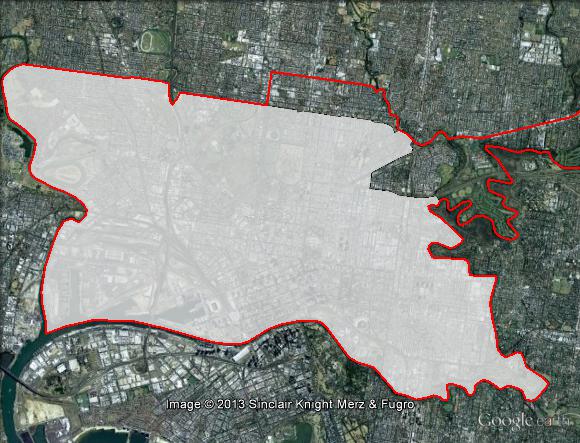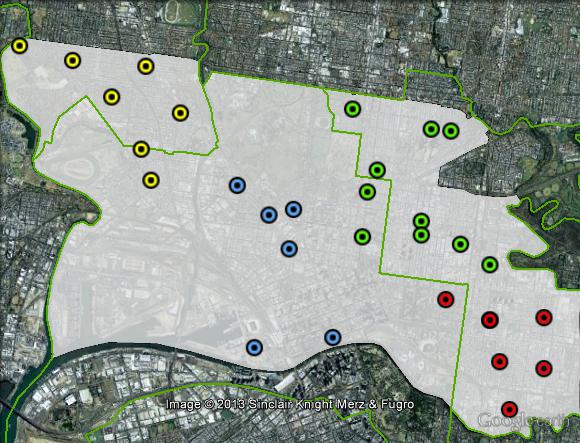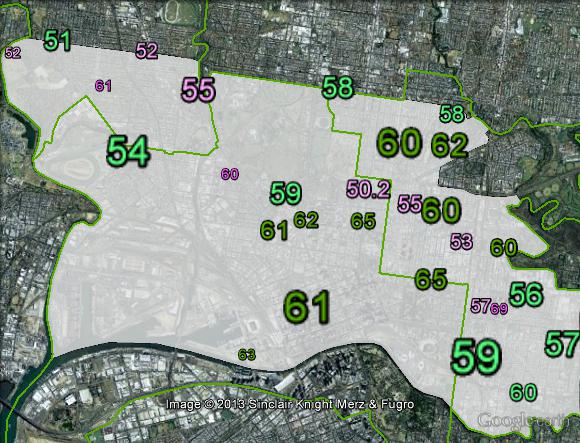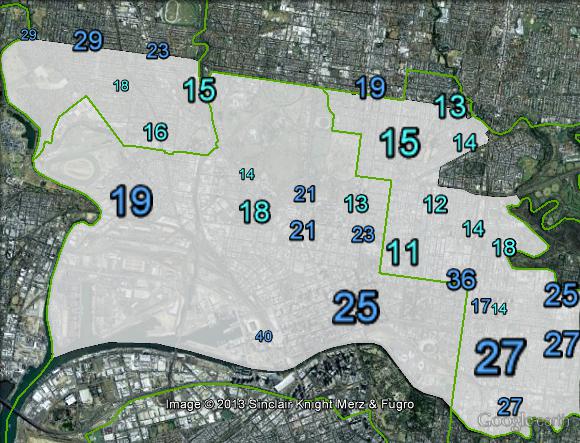GRN vs ALP 5.8%
Incumbent MP
Adam Bandt, since 2010.

Geography
Central Melbourne. Melbourne covers the Melbourne CBD, as well as the inner city suburbs of North Melbourne, Parkville, Carlton, Docklands, Abbotsford, Fitzroy, Ascot Vale, Kensington, Richmond and East Melbourne. The seat covers all of the City of Melbourne north of the Yarra River, as well as a majority of the City of Yarra and part of Moonee Valley council area.
Redistribution
Melbourne contracted to a smaller area, losing northeastern parts of the seat. Melbourne gained no extra areas, but lost areas north of Park Street around Brunswick and Fitzroy to Wills, and losing the northeastern finger of the City of Yarra to Batman.
History
Melbourne is an original Federation seat, and has been held by the ALP for over one hundred years.
The seat was first won by Malcolm McEacharn, the former Mayor of Melbourne, who joined the Protectionist Party. Although McEacharn had defeated his Labor opponent William Maloney with over 60% of the vote in 1901, the 1903 election saw McEacharn only defeat Maloney by 77 votes, and the result was declared void after allegations that the result was tainted.
Maloney defeated McEacharn at the following by-election in 1904, and the ALP have held Melbourne ever since. Maloney polled over 60% at the 1906 election, and never polled less than 60% as he held the seat right through to 1940. Indeed, Maloney was elected unopposed at two elections. Maloney retired in 1940 but died before the 1940 election. He never held a frontbench role, and holds the record for the longest term of service without serving as a frontbencher.
The seat was won in 1940 by Arthur Calwell. Calwell held the seat for thirty-two years. He served as Minister for Immigration in Ben Chifley’s government from 1945 to 1949. He served as HV Evatt’s Deputy Leader from 1951 until 1960, when he became Leader of the Opposition.
Calwell led the ALP into three federal elections. The ALP was defeated by a slim margin at the 1961 election, but suffered a larger defeat in 1963 and a solid Liberal landslide in 1966. Calwell was replaced as Leader by Gough Whitlam in 1967 and Calwell retired in 1972. At no time did the seat of Melbourne come under any serious danger of being lost.
The seat was won in 1972 by Ted Innes, who held the seat until 1983.
He was succeeded by Gerry Hand, who served as a federal minister from 1987 until his retirement at the 1993 election.
The seat was won in 1993 by Lindsay Tanner. Tanner became a frontbencher following the defeat of the Labor government in 1996, and served on the Labor frontbench right until the election of the Rudd government, and served as Finance Minister in the first term of the Labor government.
The seat of Melbourne had been considered a safe Labor seat for over a century, but at the 2007 election the Greens overtook the Liberals on preferences and came second, and the two-candidate-preferred vote saw the ALP’s margin cut to 4.7%.
In 2010, Tanner retired, and his seat was won by the Greens’ Adam Bandt, who had first run for the seat in 2007.
Candidates
- Anthony Main
- Sean Armistead (Liberal)
- Kate Borland (Independent)
- Noelle Walker (Family First)
- Adam Bandt (Greens)
- Cath Bowtell (Labor)
- Martin Vrbnjak (Palmer United Party)
- Michael Bayliss (Stable Population Party)
- Michael Murphy (Democratic Labour Party)
- Nyree Walshe (Animal Justice Party)
- Josh Davidson (Bullet Train For Australia)
- Joyce Mei Lin Khoo (Rise Up Australia)
- Royston Wilding (Secular Party)
- James Mangisi (Sex Party)
- Frazer Kirkman (Independent)
- Paul Cummins (Australian Independents)
Assessment
Melbourne is the first seat ever won by the Greens in the House of Representatives at a general election.
In 2010, the Greens achieved a record-high vote, but relied on Liberal preferences to overtake the Labor candidate and win.
The Liberal Party decided to preference Labor ahead of the Greens in the Labor/Greens marginal seats that overlap with Melbourne at the 2010 state election, and this saw no Greens elected despite a collapse in the Labor vote.
In the current circumstances, Bandt is likely to see an increase in his primary vote. He should benefit from the usual ‘sophmore surge’. His campaign is very effective at community organising and he has been prominent in the community. His role in the hung parliament and his role as Deputy Leader of the Greens have increased his profile. While the Greens have gone backwards in some polls, they have not performed badly in comparison to the ALP.
If Bandt had gained Liberal preferences, he would have won comfortably, if not by a huge margin. With Liberal preferences flowing to Labor, it will be more difficult, but it is not inconceivable that the swing to the Greens on primary votes could be enough to overcome this hurdle.
2010 result
| Candidate | Party | Votes | % | Swing |
| Cath Bowtell | ALP | 34,022 | 38.09 | -11.4 |
| Adam Bandt | GRN | 32,308 | 36.17 | +13.37 |
| Simon Olsen | LIB | 18,760 | 21.00 | -2.49 |
| Joel Murray | SXP | 1,633 | 1.83 | +1.83 |
| Georgia Pearson | FF | 1,389 | 1.55 | +0.55 |
| Penelope Green | SEC | 613 | 0.69 | +0.69 |
| David Collyer | DEM | 602 | 0.67 | -0.76 |
2010 two-candidate-preferred result
| Candidate | Party | Votes | % | Swing |
| Adam Bandt | GRN | 50,059 | 56.04 | +10.75 |
| Cath Bowtell | ALP | 39,268 | 43.96 | -10.75 |

Booth breakdown
Booths have been divided into four areas. Booths around Ascot Vale and Kensington have been grouped as West. Fitzroy, Carlton and Abbotsford are grouped as North-East. East Melbourne and Richmond are grouped as South-East. Booths close to the Melbourne CBD are grouped as Central.
The Greens won a majority of the vote in three out of four areas, varying from 55.7% in the south-east, to 58.9% in the centre. The Labor candidate won a narrow 50.7% majority in the west.
The Liberal candidate came third, polling between 15.1% in the north-east and 26.3% in the south-east.
| Voter group | LIB % | GRN 2CP % | Total votes | % of ordinary votes |
| North-East | 15.09 | 57.93 | 18,686 | 34.09 |
| South-East | 26.30 | 55.72 | 13,768 | 25.12 |
| West | 20.32 | 49.27 | 12,107 | 22.09 |
| Central | 22.49 | 58.90 | 10,249 | 18.70 |
| Other votes | 24.08 | 56.58 | 26,211 |




Why shouldn’t the Greens have fought hard to retain a seat? I fail to see the problem with that. It provides a base in the lower House for the Greens to argue for their policies there.
what is notable about Melbourne and the ACT Senate race which the Greens will probably just miss out on winning was the sheer number of community volunteers who got involved in the campaign. In a time of declining political involvement with the major parties this is an outcome to celebrate
Quite agree, Yappo, I probably went off half-cocked.
The reason I didn’t post the Crikey link is that they are behind a paywall and all many clickers will get is a teaser and an invitation to part with some cash. I am a long way from Melbourne, I don’t know what happened. I read Andrew Crook’s report, and (probably) read more into it than what actually happened.
There are broader questions about Melbourne and the methods used to keep it in Greens hands: Do the various “the means justify the ends” tactics (like the ones under discussion) mean anything at all? If so, what? Were the huge amount of effort and party resources used for one lonely, powerless backbencher well spent?
No problems, I don’t know what happened either but I think my assertions in response are reasonable. Yes a paywall makes linking a problem but I am a bit fussy on that one and still link – some readers are members and others can get around a paywall. No biggie there.
Your last para is an interesting one. Akin to the Libs sending resources to Indi in Vic at the expense of other marginals or Griffith which may have cost them winning another seat or 3? For the ALP too in terms of which seats to sandbag when they perhaps could have picked up a Solomon or a Brisbane with more resources.
I suspect that the Greens might say that winning this a second time gives them more credibility, a voice in the lower house and a good geographic platform to raise their profile for maintaining their Senate vote. It helps paint a positive picture in an election where their vote was always going to drop and they were at risk of losing a Senator or two. (Some commentators have been gleefully pointing to the drop but didn’t decrease representation – the opposite in fact)
Melb perhaps becomes an icon from which future campaigns in a Batman, a Grayndler or a Sydney might learn from – though the later two are perhaps 2 elections away from being a chance. It also shows that the Greens can keep a seat even when both majors pref against them. Fundamentally, given the demographics of this seat and as I have mentioned a couple of times they could actually keep this seat for a few elections now that they have proved that they can keep it. The next aim will be to win on 1st prefs.
That potential also has the possibility of not only building expanding a solid voter base to places like Batman but also means many potential affluent donors over the years which would easily far outweigh whatever was spent on this campaign.
The Greens will wax and wane in election cycles but the last 3 elections have shown a solid core vote of around 1m voters (8-9%) and the ability to increase Senate numbers each time. (Next election they obviously won’t get 6 elected like 2010 but 4 seems likely each time). Compare that to the Nat who have been on a clear decline in the last 2 decades, get half the Greens vote but due to regional and slight gerrymander issues obviously pick up a swag of seats – best result for a while for the Nats this time.
I’d be interested to see the informal vote in this seat. People might’ve voted for Bandt first and then just directed preferences anywhere.
I remember the late Andren in Calare refusing to tell voters where to direct their preferences, which was quite at odds with conventional practice, and Calare ended with really low rates of informal votes.
If there’s much disillusionment with the major parties, unless voters think that they have a viable alternative, the informal vote might’ve gone up, but possibly not here.
Informal voting did spike in Melbourne for this election – from 3.62% in 2010 to 6.07% in 2013. There wasn’t much change nationally – up from 5.55% in 2010 to 5.89% in 2013.
The 2013 numbers aren’t final, but include most of the votes by now.
The rise in informal votes is probably because there were so many candidates for Melbourne. The informal votes is correlated to the number of candidates.
E. Boyce
I’d call an increase of over 6 1/2 % a significant change.
winediamond – you can’t talk about percentage change of percentages. A candidate who got 10 votes in one election, then 20 votes in the next, in an electorate of 100,000, may have doubled their vote, but the change is miniscule, and not significant.
In this case, you’re referring to an increase of 0.34%. It’s an extra 50,000 people (not accounting for population growth, or turnout), across 150 electorates, meaning a typical change of about 330 per electorate. It simply cannot be considered a “significant” change, by the statistical meaning of that term.
What is more interesting is the question of which seats might have played out differently, if we assume that the 2010 informal vote is the benchmark and any increase had instead gone to the candidate that “lost” the seat (that is, the second candidate). Fairfax and McEwen both saw decreases in informal voting, so no change there. Indi saw a 1.17% increase, enough to save Mirabella. Barton ended with a margin of 0.31%, but saw an increase in informal votes of 2.22% (up to over 12%, which is absurdly high), more than enough to save McMahon for Labor. Also with sufficient change in informal voting are Parramatta (would give Liberals the seat), Dobell (would let Labor hold), Bendigo (would give Liberals the seat), and Werriwa (would give Liberals the seat).
Bringing my point back to Melbourne, it did see a significant increase in informal vote, but even then, nowhere near enough to make a real difference to the result. And while the increase in number of candidates might partially explain the increase in informal voting, I don’t think it could be called the main reason. Why? Because, for instance, in the seat of Herbert, the number of candidates doubled from 5 to 10, yet the informal vote decreased. Few of the other seats with big numbers of candidates saw increases in informal vote comparable to that of Melbourne. I think it more likely that a significant portion of the increase was due to people intentionally voting informally, or voting badly due to, for instance, not wanting to follow the Liberal HTV (wanting Greens put higher) but doing it incorrectly (I choose this example because it’s an easy situation to envisage), or things like that.